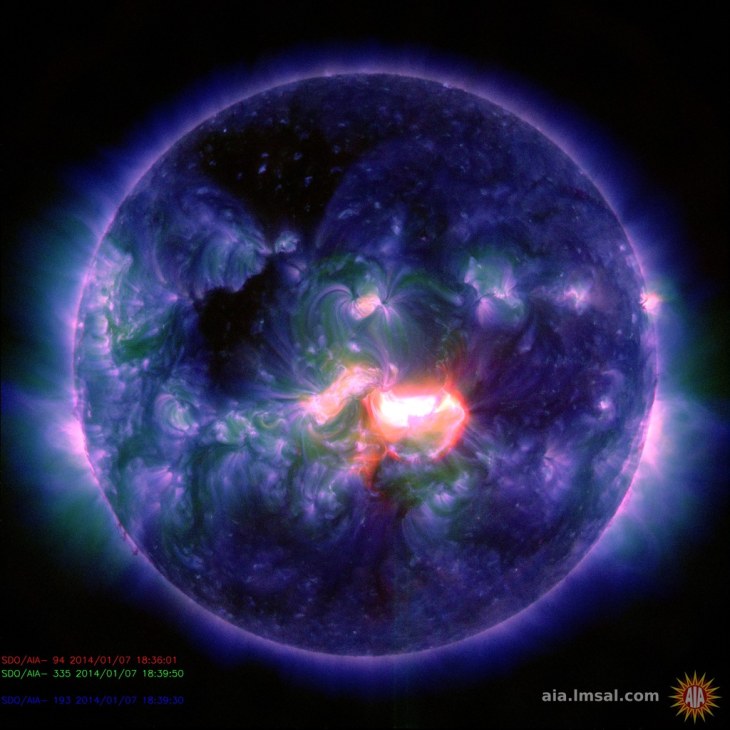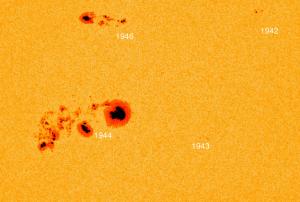Sunspot goes wild!
X-class solar flare blasts in our direction

A false-color composite image from NASA's Solar Dynamics Observatory shows a blast of activity originating from an active sunspot region at the center of the sun's disk on Tuesday.
The sun erupted with a powerful solar flare on Tuesday, disrupting radio traffic and sending a blast of electrically charged particles our way. And there may be more blasts to come.
The X1.2-class flare was recorded by sun-observing satellites, including NASA's Solar Dynamics Observatory, at about 2:32 p.m. ET. X-class flares are the strongest category of solar outbursts, although X1.2 is toward the category's low end. The National Oceanic and Atmospheric Administration's Space Weather Prediction Center said the flare sparked a strong radio blackout.
For days, space weather forecasters have been bracing themselves for solar eruptions from a large active sunspot region called AR1944. This region has now turned to face Earth directly, which means strong solar flares are likely to send storms of charged particles — also known as coronal mass ejections, or CMEs — heading straight for us.
Strong solar storms can damage satellites and electrical grids. One such outburst in 1989 knocked out power for a wide swath of Quebec. And don't get us started about thesuperstorm of 1859!
The geomagnetic storm generated by Tuesday's flare won't be that disruptive, but it could have an impact. NASA expects the CME to sweep over us somewhere around 3 p.m. ET Wednesday. The current space weather report says there's a chance we'll see more X-class flares through Friday.
Although space storms can be damaging, they can be beautiful as well: Be on the watch for enhanced northern lights over the next couple of nights. To get the auroral forecast for your area, check out the maps at SpaceWeatherLive.com. And for cool views of the aurora, keep an eye on SpaceWeather.com.
Update for 9:30 a.m. ET: Tuesday's massive solar flare has forced the commercial spaceflight company Orbital Sciences to postpone the planned launch of a private cargo mission to the International Space Station today. Read the full story here: Huge Solar Flare Delays Private Rocket Launch to Space Station
A massive solar flare erupted from the sun on Tuesday (Jan. 7), rising up from what appears to be one of the largest sunspot groups seen on the star's surface in a decade, NASA officials say.
NASA's Solar Dynamics Observatory captured a video of the huge solar flare as it developed, showing it as an intense burst of radiation from a colossal sunspot region known as AR1944. The sunspot group — which is currently in the middle of the sun as viewed from Earth — is "one of the largest sunspots seen in the last 10 years," NASA officials wrote in a statement. It is as wide as seven Earths, they added.
Tuesday's big flare was an X1.2-class solar event on the scale used to classify sun storms. It occurred at 1:32 p.m. EST (1832 GMT) and came just hours after an M7.2-class flare. Space weather officials at the the Space Weather Prediction Center overseen by NOAA are expecting the flare to spark geomagnetic storms in Earth's magnetic field when a wave of super-hot solar plasma associated with the flare - known as a coronal mass ejection - reaches Earth in the next few days. [Photos: The Biggest Solar Flares of 2014]
"This is the first significant flare of 2014, and follows on the heels of mid-level flare earlier in the day," NASA spokeswoman Karen Fox of the agency's Goddard Space Flight Center in Greenbelt, Md., wrote in a statement. "Each flare was centered over a different area of a large sunspot group currently situated at the center of the sun, about half way through its 14-day journey across the front of the disk along with the rotation of the sun."
X-class solar flares are the most powerful solar storms on the sun. Mid-level storms are dubbed M-class events and can supercharge Earth's northern lights displays, with weaker C-class flares rounding out the top three.
This labeled image taken by SDO's Helioseismic and Magnetic Imager shows the location of two act …
When aimed directly at Earth, the strongest X-class solar flares can pose a risk to astronauts in orbit and interrupt communications and navigation satellite operations.
Tuesday's solar flare did force the commercial spaceflight company Orbital Sciences to delay the launch of its first Cygnus cargo mission to the International Space Station from NASA's Wallops Flight Facility on Wallops Island, Va.
NASA officials told SPACE.com today that the crew of the International Space Station will not have to take measures to shelter themselves from the solar flare's radiation effects. There are currently six astronauts living on the station as part of the outpost's Expedition 38 crew. The team includes three Russian cosmonauts, two NASA astronauts and one Japanese astronaut.
The sun is currently in an active phase of its 11-year solar cycle. The current cycle, called Solar Cycle 24, began in 2008.


No comments:
Post a Comment